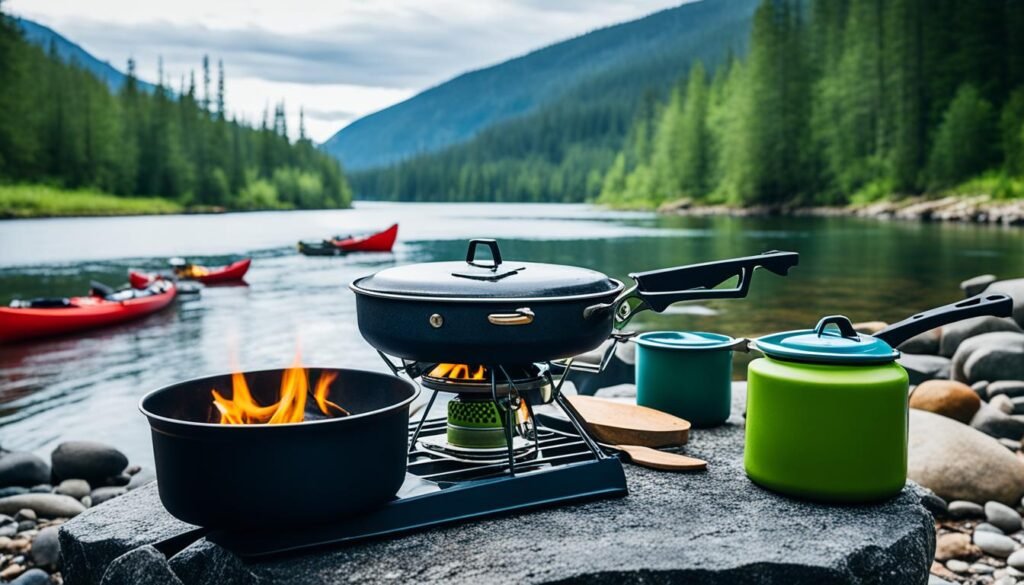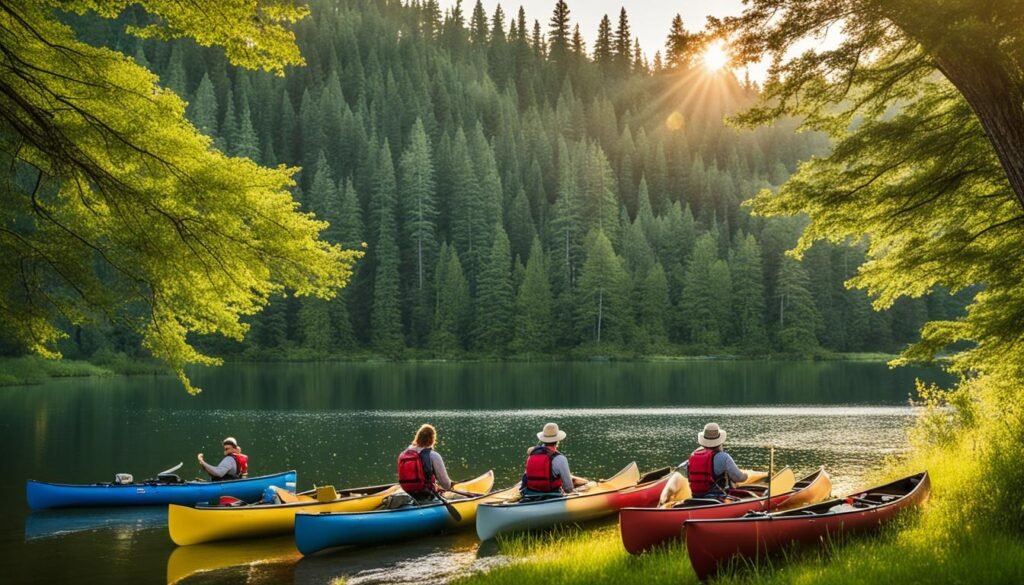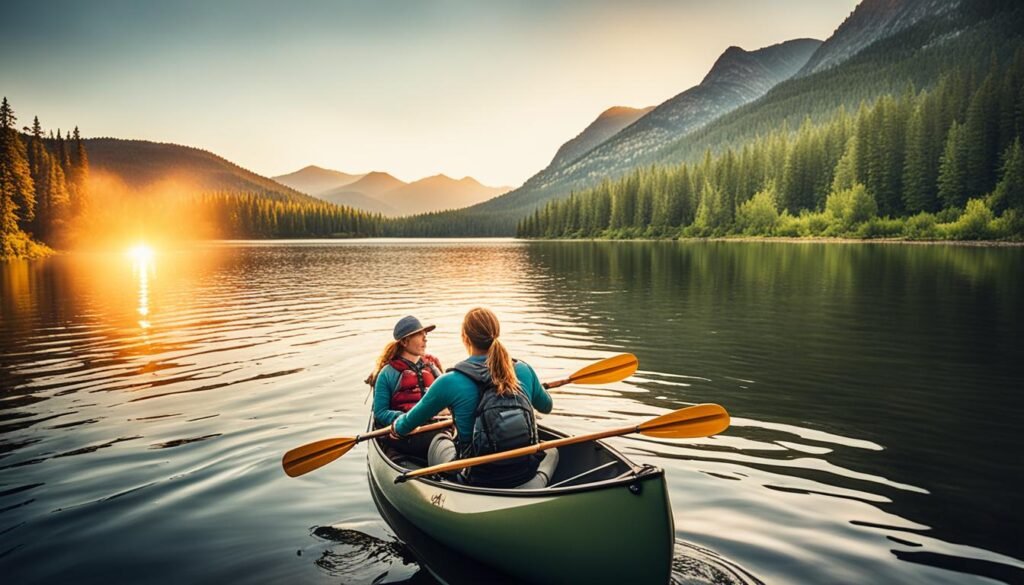Thinking about a canoe camping trip? Check out our full checklist. It includes must-haves and nice-to-haves for your journey. Our list covers everything from paddles and life jackets to maps, compasses, and first aid. Plus, we include camping musts like tents, sleeping gear, and cooking stuff.
We also talk about what clothes to bring and repair kits. With this checklist, you’ll be all set for your canoe adventure.
Key Takeaways:
- Proper gear is essential for a successful canoe camping trip.
- Pack essential items like paddles, flotation devices, maps, and a compass.
- Don’t forget camping basics like tents, sleeping bags, cooking equipment, and clothing.
- Include a repair kit and prioritize safety with proper navigation tools.
- Choose the right backpack, shelter, sleep system, and camp kitchen for your needs.
Want to make sure you have everything for your canoe trip? Download our canoe camping checklist. It’s got a full packing list for you.
Canoe Basics
Before you start a canoe camping trip, it’s important to know some canoe basics. This knowledge will help make your trip safe and fun. Here’s what you need:
- Canoe: The most important part of any canoeing trip, pick a canoe that fits your needs and is in good condition.
- Paddles: Each paddler needs their own paddle to move well on the water.
- Personal Flotation Device (PFD): Safety comes first, so each person needs a PFD that fits right.
- Dry Bags: Use dry bags to keep your stuff organized and dry.
- Spray Covers: Spray covers keep you dry from splashes and rain.
- Emergency Floating Throw Line: For emergencies, keep an emergency floating throw line with a throw bag ready.
- Bailer or Bilge Pump: Have a bailer or bilge pump in the canoe to remove water.
- Sponges: Sponges are handy for wiping up any extra water inside the canoe.
Knowing these canoe basics isn’t just about staying safe. It also makes your canoe camping trip better. With the right gear, you’ll be all set to enjoy the outdoors confidently.
Core Gear
Going on a canoe trip? You need the right gear. It keeps you safe and happy outdoors. Below are the must-haves for your list.
Navigation
Bring maps and charts. Keep them dry in a waterproof case. A compass is also key for finding your way. A GPS is extra help for accurate positioning.
Fire Starting
Starting a fire is key for warmth and cooking. Pack matches or a lighter in a dry box. These help you make a fire fast.
Multi-Tool
A good knife or multi-tool is vital. It helps in cooking, fixing gear, or cutting rope. Pick a durable one for different tasks.
Communication
It’s vital to stay in touch. Use radios or a phone in a protective bag. Phones may not work in some places, so have a backup.
Lighting
Bring lights like a headlamp or flashlight. Don’t forget extra batteries. Lights are key for seeing at night and moving around your camp.
First-Aid Supplies
A first-aid kit is a must. Include bandages, ointment, painkillers, and any prescriptions. It’s best to be ready for any small injuries or emergencies.
Protection from the Elements
Protect from the sun with sunglasses, sunscreen, and lip balm. Bring water bottles and a way to clean water. Also, pack snacks and drinks to stay energized.
Having this core gear means you’re ready for your canoe trip. Stay safe, enjoy nature, and make great memories.
Camping Basics
Packing the right gear for canoe camping is vital. It ensures a great experience overall. It gives you comfort from sleeping to eating. Below are the must-have items for your next adventure.
Tent
A tent is key for a good sleep. Pick a lightweight one that’s easy to set up. It should fit you and your gear well.
Sleeping Bag and Sleeping Pad
Choose a sleeping bag right for the weather. Add a comfy sleeping pad for insulation. This combo ensures a restful night.
Meals and Snacks
Bring meals and snacks that are light and last long. They should be easy to make. And give you the energy you need.
Cooler
A cooler keeps food and drinks cold. Go for one that’s small but tough. Make sure it can handle being outdoors.
Stove and Fuel
You’ll need a stove and fuel for cooking. Find a stove that’s small and simple to use. Also, have enough fuel for your trip.
Cookset and Utensils
Don’t forget pots, pans, and cooking tools. Include a spatula and spoon. These are needed for your meals.
Dishes, Bowls, and Cups
Pack dishes, bowls, and cups for eating. Choose ones that are light and strong. They should be easy to clean too.
Insect Repellent
Take a good insect repellent with you. It should work well outside. And keep bugs away for a long time.
Toilet Paper and Hand Sanitizer
Hygiene is important. Always have toilet paper and hand sanitizer with you. They keep you clean and germ-free.
Camera and Binoculars
Bring a camera to capture the views. Binoculars will help you see wildlife. They make your trip more fun.
Packable Lantern
A lantern is useful at night. Find one that’s light and small. It should give off a strong, adjustable light.
Credit Card and Trip Itinerary
Keep a credit card for emergencies. Also, prepare a detailed trip plan. Share it with someone and keep a copy in your car.
Remember these essentials for a great canoe camping experience. Being ready means more fun and beautiful memories in nature.
| Item | Description |
|---|---|
| Tent | A lightweight and reliable shelter for a comfortable night’s sleep. |
| Sleeping Bag | A high-quality sleeping bag suitable for expected temperature conditions. |
| Sleeping Pad | A comfortable and insulating pad for cushioning and insulation from the ground. |
| Meals and Snacks | Lightweight and non-perishable options for fueling outdoor adventures. |
| Cooler | A compact and durable cooler for keeping food fresh and drinks cold. |
| Stove and Fuel | A portable camping stove and fuel for cooking meals and boiling water. |
| Cookset and Utensils | Pots, pans, and utensils specifically designed for outdoor cooking. |
| Dishes, Bowls, and Cups | Lightweight and durable options for serving and enjoying meals. |
| Insect Repellent | An effective formula for protecting against pesky insects. |
| Toilet Paper and Hand Sanitizer | Essential hygiene items for cleanliness and sanitation. |
| Camera and Binoculars | Essential items for capturing memories and appreciating nature. |
| Packable Lantern | A lightweight and compact light source for nighttime activities. |
| Credit Card and Trip Itinerary | Payment method and a detailed plan of your trip for emergencies and organization. |
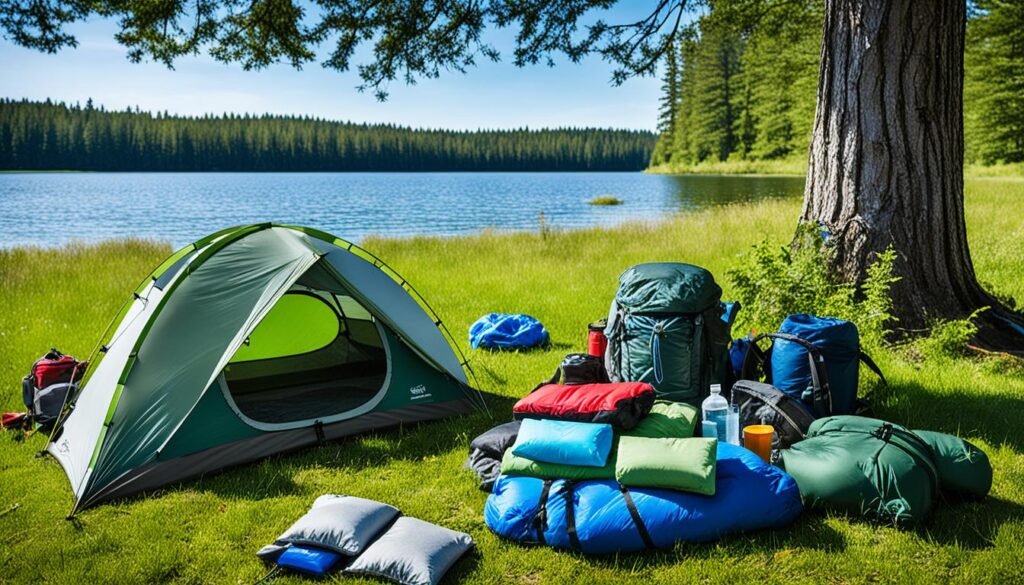
Clothing
Choosing the right clothes is vital for your comfort and safety on a canoe trip. Think about what you’ll do and the weather. Always be prepared.
Wearing a dry suit or top keeps you dry and warm in cold water. Add paddling gloves or pogies to protect your hands. Wear neoprene boots or waterproof sandals for comfort and safety by the water.
A helmet is important for safety in rough rapids. A sun-shielding hat protects from the sun, and a hat or cap retainer keeps it secure. Also, wear a skullcap, bandana, or buff for extra protection.
Don’t forget a wool or synthetic cap or balaclava for cold weather. Wear moisture-wicking T-shirts and underwear for comfort. A rashguard works well for water activities.
Choose clothes that dry quickly, like shorts or convertible pants. Wear sun-shielding shirt and pants against UV rays. Always have a spray jacket or rainwear ready for rain.
Layering is crucial in cold weather. Bring a synthetic vest or jacket for warmth. Also, wear synthetic gloves or mittens to keep your hands warm.
Repair-Kit Options
A repair kit is key for handling equipment problems during a canoe camping trip. Being prepared is always a good idea for any surprises. Look at these options for a repair-kit:
- Sealant: Aquaseal is a top-choice sealant for fixing leaks and minor cracks, keeping gear watertight.
- Bailing Wire: Bailing wire is useful for many repairs, like tightening loose parts and reinforcing connections.
- Nylon Cord: Nylon or bungee cords are great for fastening items, making temporary straps, or gear repair.
- Putty: Putty can patch cracks and holes, offering a quick fix until a full repair is done.
- Replacement Nuts/Bolts: Having extra nuts and bolts is smart, as they can get lost or broken on trips.
Quick Tip:
Always have your repair/duct tape ready. It is super useful for many repairs, like patching gear or fixing straps. Duct tape is flexible and helps with quick fixes until you can do more permanent repairs.
By packing these repair-kit choices, you’re ready for small problems. This way, your gear stays working well during your canoe camping adventure.
Safety
Safety should always come first during your canoe camping trip. Being prepared and cautious ensures a fun and safe journey. Here are key tips for safety:
Location Research
Know your location before you go. Learn about the trails, camping spots, distances, and water sources. Also, know about emergencies, wildlife, weather, and local rules. This information keeps you safe and informed.
Navigation
Having the right navigation tools is vital. Bring maps, a compass, and a GPS. These tools help you stay on track and find your way.
Water Safety
Water safety is crucial when canoe camping. Always wear a personal flotation device (PFD), no matter how well you swim. Be mindful of dangers like currents and avoid risky moves in the canoe. Safe practices reduce the risk of accidents.
First Aid Kit
Always pack a comprehensive first aid kit. Include bandages, pain relievers, antiseptic wipes, and prescriptions. Knowing basic first aid is important. Make sure someone can give first aid if needed.
Campsite Safety
Choose a safe place to camp. Avoid hazards like dead trees or dangerous waters. Pitch your tent on flat ground. Keep your site clean to not attract animals. Also, follow fire safety rules. Fires should be in safe spots and fully put out when done.
Following these tips ensures a safe canoe camping experience. Remembering safety helps make your adventure memorable and enjoyable. Safety is always the most important!
Backpack
It’s important to pick the right backpack for your canoe camping trip. Think about its size, how it works, and if it suits your needs.
Size Matters
A 40L backpack is a good choice for most canoe camping trips. It has enough room but isn’t too big. If you have a longer trip or more stuff, you might need a bigger one. Think about what you need and how long you’ll be gone to choose the best size.
Specialized Canoe Packs
For canoe camping, a waterproof canoe pack is a great investment. These packs keep your gear safe from water and are easy to carry while paddling. They are strong and have features that help organize your things.
Backpacking Versatility
If you like different outdoor activities, choose a versatile backpack. Look for one that’s comfortable, works well, and lasts a long time. It should have straps you can adjust, many pockets, and a system to support your back. This makes your trip better.
Comfort and Fit
Make sure your backpack fits well and feels nice to carry. It should have straps you can change and a padded back. Also, look for a hip belt and straps to lift the load. This helps spread the weight and eases pressure on your back and shoulders. Try different backpacks and adjust them to find the best fit.
Picking the right backpack is key for a great canoe camping trip. Think about its size, special features, and how it fits. This ensures you have a good time on your adventure.
Shelter
Finding the right shelter means better sleep on a canoe camping trip. Think about the season, weather, and what feels right.
Remember, the right shelter can make all the difference in your camping experience.
Traditional Tents
Tents are a tested choice for camping shelter. They vary in size and style to fit any group or weather. Look for waterproof, sturdy ones that are easy to set up.
Hammock Camping
Hammock camping lets you sleep above the ground. It’s light and perfect for places with little flat ground. Pick a hammock with protection from bugs and rain.
Tarp Tents
Tarp tents are both light and flexible for shelter. They’re simple to use and keep you covered. Ensure your tarp is strong, waterproof, and well-made.
Pick a shelter that meets your needs and keeps you safe from weather. A good shelter means you’ll sleep well and enjoy your adventure more.
Sleep System
A good sleep system is crucial for a great night’s sleep during your trip. When you’re under the stars, the right gear keeps you cozy all night.
Sleeping Bag
Choose a top-notch sleeping bag for the temperature you’ll face. It should keep you warm but not too hot. Pick a bag that’s light and easy to carry.
Consider its size, weight, and how easy it is to pack.
Sleeping Pad
A comfy sleeping pad makes a big difference. It stops the cold ground from making you chilly. Find one that’s light and simple to use.
It should be thick enough for comfort. You’ll like having it on cold nights.
Packable Pillow
Don’t forget a packable pillow for extra comfort. It supports your head and neck for better sleep. Choose a pillow that’s light and small when packed.
“A good sleep system can make all the difference in the quality of your rest during a canoe camping adventure. Invest in a high-quality sleeping bag, a comfortable sleeping pad, and a packable pillow to ensure you wake up refreshed and ready for another day of paddling.”
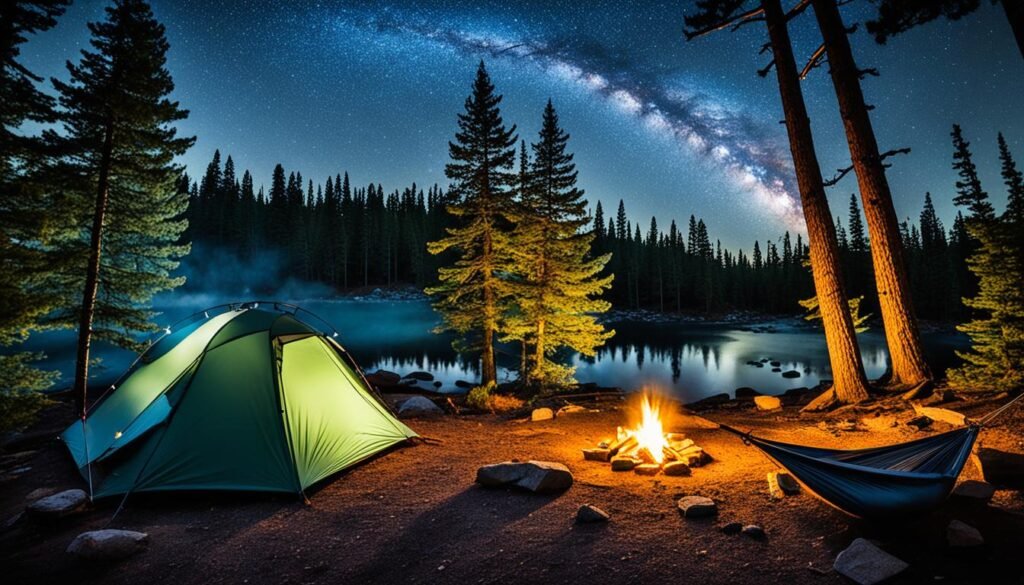
| Sleep System Essentials | Description |
|---|---|
| Sleeping Bag | A high-quality bag that provides insulation and weight management. |
| Sleeping Pad | A comfortable and insulating pad that provides cushioning and warmth. |
| Packable Pillow | A lightweight and compressible pillow for added comfort and support. |
Camp Kitchen
A well-equipped camp kitchen is key for yummy meals on your canoe trip. Be sure to pack a variety of foods and drinks. Bring meals, coffee, tea, hot chocolate, snacks, and your favorite spices.
Remember cooking oil or butter so food won’t stick. You’ll need a camp stove and fuel to cook. Don’t forget pots and pans for boiling water and cooking. A portable grill is great for grilling lovers.
Pack the right utensils for easy food handling. Include a spatula, spoon, cutting board, knife, and can-opener. For cleaning, bring a dish kit with biodegradable soap, a dishcloth, and steel wool. Also, have a way to purify drinking water.
With all you need, enjoy great meals surrounded by nature. Cook up a big breakfast or a tasty dinner. Your camp kitchen will make your canoe camping trip even better.
FAQ
What should I bring for canoe camping?
You’ll need a canoe, paddles, and life jackets. Remember dry bags, spray covers, and a throw line for safety. Also, grab a bailer or pump, maps, compass, GPS, and fire starters. Don’t forget a knife, radios, phone, light, first aid, sunglasses, sunscreen, and lip balm. Pack water bottles, a way to purify water, food, and your favorite drinks.
What are the canoe basics I need for canoe camping?
Start with a canoe, paddles, and life jackets. Bring extra paddles and jackets too. Add a comfortable seat and knee pads. A yoke with pads, dry bags, and spray covers are key. Also have a throw line, bailer or pump, and sponges.
What core gear should I bring for canoe camping?
Bring maps and charts in a waterproof case. You’ll need a compass and a GPS. Matches or a fire starter in a waterproof container are a must. Add a knife, radios, a protected cell phone, and a light with extra batteries. Remember first aid, sunglasses, sunscreen, lip balm, water and treatment, food, and drinks.
What camping basics are important for canoe camping?
For shelter, take a tent, tarp, or bivy sack. You’ll sleep well with a good bag and pad. Bring meals, snacks, and a cooler. A stove, fuel, cookset, utensils, and dishes are needed. Don’t forget bug spray, toilet paper, sanitizer, a camera, binoculars, and a lantern. Bring a credit card and leave an itinerary with a friend.
What clothing should I bring for canoe camping?
Wear a dry suit or top, paddling gloves, and water shoes. Bring sandals for the shore. Don’t forget a helmet, hats for sun and warmth, and a bandana. Wear moisture-wicking T-shirts and underwear. Have a rashguard for water fun. Pack swimwear, shorts or pants, sun-protective clothes, and a spray jacket. Add a warm vest or jacket and gloves for cold.
What repair-kit options should I include for canoe camping?
Include Aquaseal, bailing wire, and nylon or bungee cords. Don’t forget putty, extra nuts/bolts, and tape. These items help with quick fixes.
What safety precautions should I take for canoe camping?
Learn about your location and trail before you start. Know your campsites, distances, and water sources. Have emergency contacts, understand wildlife and weather. Always use a map, compass, and GPS. Wear a life jacket on water. Carry a first aid kit. Follow campsite rules to stay safe.
What type of backpack should I choose for canoe camping?
Pick a 40L backpack or bigger for basics. A waterproof canoe pack is best for gear. For variety, try a backpacking backpack. Make sure it’s comfy for your adventures.
What type of shelter should I choose for canoe camping?
Choose based on time of year, weather, and preferences. Options are tents, hammock camping, and tarp tents. Tents are reliable, hammocks are unique, and tarps are versatile. Pick what suits you and keeps you safe from weather.
What sleep system should I have for canoe camping?
Get a sleeping bag that matches the weather. Look at weight, packability, and insulation. Use a sleeping pad for comfort and warmth. Consider a packable pillow for extra comfort.
What should I include in my camp kitchen for canoe camping?
Pack a variety of food and drinks, like meals and coffee. Remember cooking oil, a stove and fuel, pots, and a grill if you want. Bring a spatula, knife, and can-opener. Have a dish kit with soap and a water treatment method. You can enjoy great meals while out in nature.

